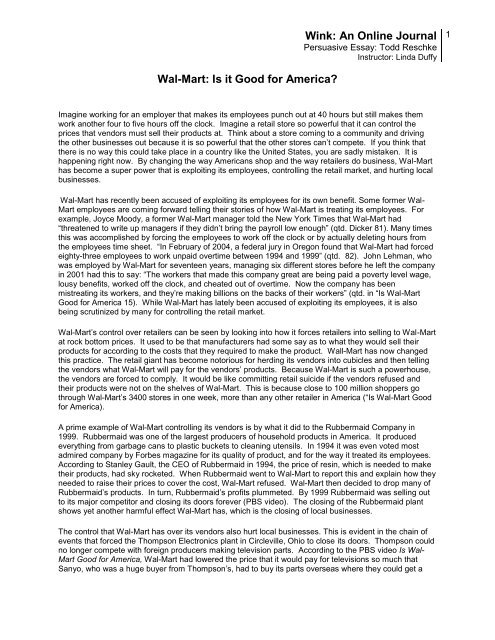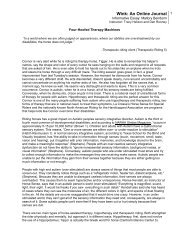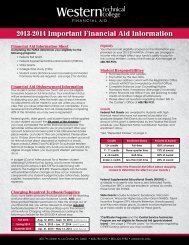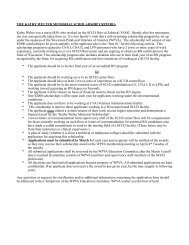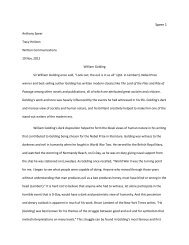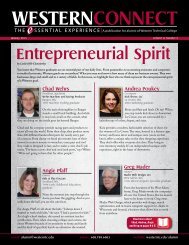Wink: An Online Journal Wal-Mart: Is it Good for America?
Wink: An Online Journal Wal-Mart: Is it Good for America?
Wink: An Online Journal Wal-Mart: Is it Good for America?
You also want an ePaper? Increase the reach of your titles
YUMPU automatically turns print PDFs into web optimized ePapers that Google loves.
<strong>Wink</strong>: <strong>An</strong> <strong>Online</strong> <strong>Journal</strong><br />
Persuasive Essay: Todd Reschke<br />
Instructor: Linda Duffy<br />
1<br />
<strong>Wal</strong>-<strong>Mart</strong>: <strong>Is</strong> <strong>it</strong> <strong>Good</strong> <strong>for</strong> <strong>America</strong>?<br />
Imagine working <strong>for</strong> an employer that makes <strong>it</strong>s employees punch out at 40 hours but still makes them<br />
work another four to five hours off the clock. Imagine a retail store so powerful that <strong>it</strong> can control the<br />
prices that vendors must sell their products at. Think about a store coming to a commun<strong>it</strong>y and driving<br />
the other businesses out because <strong>it</strong> is so powerful that the other stores can’t compete. If you think that<br />
there is no way this could take place in a country like the Un<strong>it</strong>ed States, you are sadly mistaken. It is<br />
happening right now. By changing the way <strong>America</strong>ns shop and the way retailers do business, <strong>Wal</strong>-<strong>Mart</strong><br />
has become a super power that is explo<strong>it</strong>ing <strong>it</strong>s employees, controlling the retail market, and hurting local<br />
businesses.<br />
<strong>Wal</strong>-<strong>Mart</strong> has recently been accused of explo<strong>it</strong>ing <strong>it</strong>s employees <strong>for</strong> <strong>it</strong>s own benef<strong>it</strong>. Some <strong>for</strong>mer <strong>Wal</strong>-<br />
<strong>Mart</strong> employees are coming <strong>for</strong>ward telling their stories of how <strong>Wal</strong>-<strong>Mart</strong> is treating <strong>it</strong>s employees. For<br />
example, Joyce Moody, a <strong>for</strong>mer <strong>Wal</strong>-<strong>Mart</strong> manager told the New York Times that <strong>Wal</strong>-<strong>Mart</strong> had<br />
“threatened to wr<strong>it</strong>e up managers if they didn’t bring the payroll low enough” (qtd. Dicker 81). Many times<br />
this was accomplished by <strong>for</strong>cing the employees to work off the clock or by actually deleting hours from<br />
the employees time sheet. “In February of 2004, a federal jury in Oregon found that <strong>Wal</strong>-<strong>Mart</strong> had <strong>for</strong>ced<br />
eighty-three employees to work unpaid overtime between 1994 and 1999” (qtd. 82). John Lehman, who<br />
was employed by <strong>Wal</strong>-<strong>Mart</strong> <strong>for</strong> seventeen years, managing six different stores be<strong>for</strong>e he left the company<br />
in 2001 had this to say: “The workers that made this company great are being paid a poverty level wage,<br />
lousy benef<strong>it</strong>s, worked off the clock, and cheated out of overtime. Now the company has been<br />
mistreating <strong>it</strong>s workers, and they’re making billions on the backs of their workers” (qtd. in “<strong>Is</strong> <strong>Wal</strong>-<strong>Mart</strong><br />
<strong>Good</strong> <strong>for</strong> <strong>America</strong> 15). While <strong>Wal</strong>-<strong>Mart</strong> has lately been accused of explo<strong>it</strong>ing <strong>it</strong>s employees, <strong>it</strong> is also<br />
being scrutinized by many <strong>for</strong> controlling the retail market.<br />
<strong>Wal</strong>-<strong>Mart</strong>’s control over retailers can be seen by looking into how <strong>it</strong> <strong>for</strong>ces retailers into selling to <strong>Wal</strong>-<strong>Mart</strong><br />
at rock bottom prices. It used to be that manufacturers had some say as to what they would sell their<br />
products <strong>for</strong> according to the costs that they required to make the product. <strong>Wal</strong>l-<strong>Mart</strong> has now changed<br />
this practice. The retail giant has become notorious <strong>for</strong> herding <strong>it</strong>s vendors into cubicles and then telling<br />
the vendors what <strong>Wal</strong>-<strong>Mart</strong> will pay <strong>for</strong> the vendors’ products. Because <strong>Wal</strong>-<strong>Mart</strong> is such a powerhouse,<br />
the vendors are <strong>for</strong>ced to comply. It would be like comm<strong>it</strong>ting retail suicide if the vendors refused and<br />
their products were not on the shelves of <strong>Wal</strong>-<strong>Mart</strong>. This is because close to 100 million shoppers go<br />
through <strong>Wal</strong>-<strong>Mart</strong>’s 3400 stores in one week, more than any other retailer in <strong>America</strong> (“<strong>Is</strong> <strong>Wal</strong>-<strong>Mart</strong> <strong>Good</strong><br />
<strong>for</strong> <strong>America</strong>).<br />
A prime example of <strong>Wal</strong>-<strong>Mart</strong> controlling <strong>it</strong>s vendors is by what <strong>it</strong> did to the Rubbermaid Company in<br />
1999. Rubbermaid was one of the largest producers of household products in <strong>America</strong>. It produced<br />
everything from garbage cans to plastic buckets to cleaning utensils. In 1994 <strong>it</strong> was even voted most<br />
admired company by Forbes magazine <strong>for</strong> <strong>it</strong>s qual<strong>it</strong>y of product, and <strong>for</strong> the way <strong>it</strong> treated <strong>it</strong>s employees.<br />
According to Stanley Gault, the CEO of Rubbermaid in 1994, the price of resin, which is needed to make<br />
their products, had sky rocketed. When Rubbermaid went to <strong>Wal</strong>-<strong>Mart</strong> to report this and explain how they<br />
needed to raise their prices to cover the cost, <strong>Wal</strong>-<strong>Mart</strong> refused. <strong>Wal</strong>-<strong>Mart</strong> then decided to drop many of<br />
Rubbermaid’s products. In turn, Rubbermaid’s prof<strong>it</strong>s plummeted. By 1999 Rubbermaid was selling out<br />
to <strong>it</strong>s major compet<strong>it</strong>or and closing <strong>it</strong>s doors <strong>for</strong>ever (PBS video). The closing of the Rubbermaid plant<br />
shows yet another harmful effect <strong>Wal</strong>-<strong>Mart</strong> has, which is the closing of local businesses.<br />
The control that <strong>Wal</strong>-<strong>Mart</strong> has over <strong>it</strong>s vendors also hurt local businesses. This is evident in the chain of<br />
events that <strong>for</strong>ced the Thompson Electronics plant in Circleville, Ohio to close <strong>it</strong>s doors. Thompson could<br />
no longer compete w<strong>it</strong>h <strong>for</strong>eign producers making television parts. According to the PBS video <strong>Is</strong> <strong>Wal</strong>-<br />
<strong>Mart</strong> <strong>Good</strong> <strong>for</strong> <strong>America</strong>, <strong>Wal</strong>-<strong>Mart</strong> had lowered the price that <strong>it</strong> would pay <strong>for</strong> televisions so much that<br />
Sanyo, who was a huge buyer from Thompson’s, had to buy <strong>it</strong>s parts overseas where they could get a
<strong>Wink</strong>: <strong>An</strong> <strong>Online</strong> <strong>Journal</strong><br />
Persuasive Essay: Todd Reschke<br />
Instructor: Linda Duffy<br />
2<br />
cheaper price. Thompson Electronics employed approximately 1000 people in a town of 13,000. It paid<br />
<strong>it</strong>s employees decent wages and offered them benef<strong>it</strong>s, including health and retirement packages. Steve<br />
Ratcliff, a machine operator <strong>for</strong> Thomson, reported making an average yearly salary of $59,000 per year<br />
including his overtime. In early 2003, Thompson had lost one of <strong>it</strong>s biggest accounts <strong>for</strong> Sanyo<br />
televisions, and by May 2003 Thompson’s Electronics was closing the Circleville’s plant <strong>for</strong> good.<br />
Ironically, <strong>Wal</strong>-<strong>Mart</strong> is constructing a new store next to the vacant Thompson Electronic’s store (“<strong>Is</strong> <strong>Wal</strong>-<br />
<strong>Mart</strong> <strong>Good</strong> <strong>for</strong> <strong>America</strong>”). A survey that was done in Iowa also concluded the damage that <strong>Wal</strong>-<strong>Mart</strong> had<br />
done to local businesses from 1983 to 1995. This survey showed that half of local clothing stores had<br />
closed their doors due to <strong>Wal</strong>-<strong>Mart</strong>. Thirty percent of hardware stores had closed. One quarter of all<br />
building material stores were out of business. Almost half of all variety stores were gone. Twenty nine<br />
percent of all the shoe retailers had closed. Seventeen percent of the jewelry retailers had been <strong>for</strong>ced to<br />
close, and almost 30 percent of the department stores had closed their doors <strong>for</strong> good due to the<br />
migration of <strong>Wal</strong>-<strong>Mart</strong> to these rural commun<strong>it</strong>ies (Bill Quinn 4).<br />
Many people will argue that <strong>Wal</strong>-<strong>Mart</strong> is good <strong>for</strong> the economy because <strong>it</strong> brings jobs to commun<strong>it</strong>ies.<br />
However, what <strong>America</strong>ns need to be aware of is what types of jobs <strong>Wal</strong>-<strong>Mart</strong> is bringing to commun<strong>it</strong>ies.<br />
According to Wisconsin’s Department of Health and Family Services: “In Wisconsin, <strong>Wal</strong>-<strong>Mart</strong> employees<br />
and their dependents rack up an annual bill of $4.75 million, through a combination of their use of the<br />
state’s “Badger Care” insurance <strong>for</strong> low-income working families and Medicaid. According to numbers<br />
from the state’s health department, 3,765 <strong>Wal</strong>-<strong>Mart</strong> associates and their dependents receive public<br />
assistance” (Dicker 85,86). <strong>An</strong>other national statistic from an article in Newsweek magazine found that<br />
nearly 50 percent of the children of <strong>Wal</strong>-<strong>Mart</strong> employees were on some sort of governmental assistance<br />
program (McGinn 42). So while <strong>Wal</strong>-<strong>Mart</strong> is creating jobs, the jobs <strong>it</strong> is creating are not the type of jobs<br />
that <strong>America</strong>ns are able to support their families w<strong>it</strong>h.<br />
A prime example of this is Josh Noble’s story about working <strong>for</strong> <strong>Wal</strong>-<strong>Mart</strong>. When Josh took a job at his<br />
local <strong>Wal</strong>-<strong>Mart</strong> in Loveland, Colorado, he was a typical high school kid who just wanted to earn some<br />
extra money after school. Josh was employed in <strong>Wal</strong>-<strong>Mart</strong>’s automotive garage, where he changed tires<br />
and installed batteries. In<strong>it</strong>ially Josh liked his job. He enjoyed working on cars and earning some extra<br />
spending money. After high school, Josh’s att<strong>it</strong>ude soon changed. Although Josh decided to move up to<br />
a full time employee, his wages were so low that he could not af<strong>for</strong>d the health care that <strong>Wal</strong>-<strong>Mart</strong> had to<br />
offer. He did some investigating and found that he was paid less at <strong>Wal</strong>-<strong>Mart</strong> than the local grocery<br />
stores in town. Josh’s wages were not even enough to pay <strong>for</strong> an apartment that he had rented, <strong>for</strong>cing<br />
him to move back in w<strong>it</strong>h his parents (“Labor Pains”).<br />
People will also argue that they can go to <strong>Wal</strong>-<strong>Mart</strong> and fill their carts <strong>for</strong> less money than they would be<br />
able to at other retail stores. However, this is not true all of the time, according to John Lehman, an ex<br />
<strong>Wal</strong>-<strong>Mart</strong> store manager. He says that many times the consumer is tricked into thinking they are getting<br />
the lowest price in town. This is accomplished by placing <strong>it</strong>ems on an end cap at ridiculously low prices.<br />
The consumer then thinks that every <strong>it</strong>em in the store is priced low when actually the other <strong>it</strong>ems are not<br />
the best prices in town (“<strong>Is</strong> <strong>Wal</strong>-<strong>Mart</strong> <strong>Good</strong> <strong>for</strong> <strong>America</strong>”). These consumers need to ask themselves the<br />
question. Are these low prices they think they are getting worth the jobs that were lost, and the<br />
businesses that were destroyed? They also need to a keep in mind Steve Ratcliff’s story. Some people<br />
will argue that he could get a job at the <strong>Wal</strong>-<strong>Mart</strong> store being built in his home town, but he will never be<br />
able to equal the type of pay that he received at his previous job.<br />
<strong>Wal</strong>-<strong>Mart</strong> has defin<strong>it</strong>ely become part of many <strong>America</strong>n’s routine shopping trips. While <strong>America</strong>ns may be<br />
able to save a few dollars by shopping at <strong>Wal</strong>-<strong>Mart</strong>, they need to ask themselves: <strong>Is</strong> the low cost of <strong>Wal</strong>-<br />
<strong>Mart</strong>’s merchandise worth the high price of lost jobs and businesses that they must pay to get these<br />
prices? According to The Economist Magazine, “In <strong>America</strong> this year, <strong>Wal</strong>-<strong>Mart</strong> intends to open some 50<br />
new discount stores and more than 220 new super centers, some of which will be existing stores moving<br />
to new locations. Overseas, <strong>it</strong> plans another 140 or so new stores, including relocations. This adds up to<br />
some 50 million square feet of new space – even more than many of <strong>it</strong>s rivals operate in total” (qtd. “How
<strong>Wink</strong>: <strong>An</strong> <strong>Online</strong> <strong>Journal</strong><br />
Persuasive Essay: Todd Reschke<br />
Instructor: Linda Duffy<br />
3<br />
Big Can <strong>it</strong> Grow”). The article also goes on to state that these stores will hire new employees and pay<br />
them as l<strong>it</strong>tle as eight dollars per hour, which is twenty to thirty percent less than rival supermarkets would<br />
pay them.. So as <strong>America</strong>n consumers head out this Christmas to do their shopping they need to ask<br />
themselves the question. Should <strong>Wal</strong>-<strong>Mart</strong> be compared to Santa Claus, or is <strong>it</strong> better compared to<br />
Scrooge?<br />
Works C<strong>it</strong>ed<br />
Dicker, John. The Un<strong>it</strong>ed States of <strong>Wal</strong>-<strong>Mart</strong>. New York: The Penguin Group, 2005.<br />
"How Big Can <strong>it</strong> Grow?" The Economist 15 Apr. 2004: 1-6.<br />
<strong>Is</strong> <strong>Wal</strong>mart <strong>Good</strong> <strong>for</strong> <strong>America</strong>? Dir. Frontline. Videocassette. PBS Video, 2004.<br />
"Labor Pains." The New York Times Upfront 14 Nov. 2005: 12.<br />
McGinn, Daniel. "<strong>Wal</strong>-<strong>Mart</strong> H<strong>it</strong>s the <strong>Wal</strong>l." Newsweek 14 Nov. 2005: 42-44.<br />
Quinn, Bill. How <strong>Wal</strong>-<strong>Mart</strong> is Destroying <strong>America</strong>. Berkley: Ten Speed P, 2000.<br />
April 2, 2006


